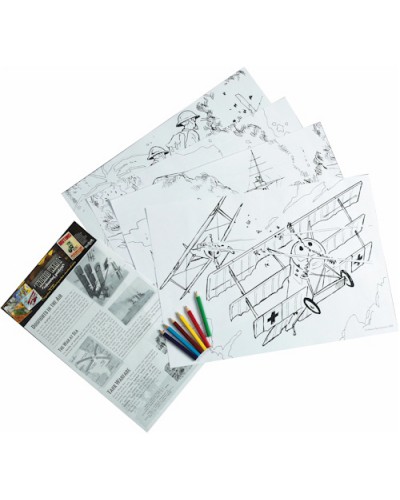Product Description: The World War I Colouring Posters consists of four A3 size colouring sheets, six colouring pencils and a World War I factsheet. The colouring posters include an image of British soldiers ‘going over the top’, an aeroplane dog fight, a tank on the battlefield and a ship under fire. The factsheet explains how World War I started, life in the trenches, dogfights in the air, the war at sea, tank warfare and there is also a crossword to complete. There is a colourful header card that has pictures showing how the posters could be coloured in and information on a recruitment poster, a George V coin and how World War developed into a trench fought campaign. All are held in a clear cellophane bag.
Information: World War I started in 1914 after the heir to the Austro-Hungarian throne, Archduke Ferdinand, was assassinated in Sarajevo, Bosnia. Austria-Hungary blamed Serbia for the assassination and on 28th July declared war on them, which soon turned into a European war.
Russia supported Serbia, Germany supported Austro-Hungary and France supported Russia. On the 4th August 1914 Germany invaded neutral Belgium hoping to knock out France before turning its attention to Russia. Britain had guaranteed to defend Belgium’s neutrality and it too declared war on Germany on this date.
Armies were mobilised, factories changed to manufacture supplies and materials for the war and women took the place of men in the factories. These women worked in munitions and other factories as well as creating the ‘Womens Land Army’ whose job it was to run the farms.
Death was a constant companion to those serving in the line, even when no raid or attack was launched or defended against. Both sides fired tens of thousands of shells at each other resulting in huge casualties to the soldiers whether they were hiding in a trench or lying in a dugout. The troops also had to deal with rat infested trenches, disease, the cold, poor or no food and the constant fear of death at any moment.
The floors of these trenches were made from wooden planks called duckboards and the sides were supported by sandbags. Whole systems of trenches, backup trenches (in case the first lines were overrun) and communication trenches were developed, often stretching dozens of kilometres along a front without interruption. Both allied and enemy troops were sent ‘over the top’ of these trenches to attack each other, often with disastrous consequences.
The term 'dogfight' originated during World War I and referred to aerial combat between fighter aircraft. Aircraft were initially used as mobile observation vehicles. These aircraft soon became targets from other planes who originally threw bricks, grenades and fired pistols at them. Once machine guns were mounted to these and other planes, either on a flexible mounting or higher on the wings of early biplanes, the era of air combat began.
The Battle of Jutland was the largest naval battle of World War I between the Royal Navy and the German Navy and the only full-scale clash of battleships in that war. It was fought on 31 May – 1 June 1916, in the North Sea near Jutland and at the end of the battle both sides claimed victory. The Germans continued to pose a threat but they never again contested control of the high seas. Instead, the German Navy turned its efforts and resources to unrestricted submarine warfare. Rationing was introduced into Britain at the tail end of world War One (February 1918), introduced in response to this effective U-boat campaign.
During World War I the British invented and implemented the first working tank. The name tank came when the British shipped them in crates marked ‘tanks’ trying to cover up what they really were. The tank was first employed in significant numbers at the Battle of the Somme. Though the tank was highly unreliable, it did a great deal to end the horrors of trench warfare and brought back some mobility to the Western Front.
Tags: World War I, Educational, Colouring, Posters

